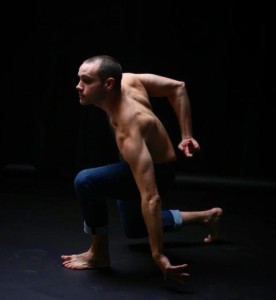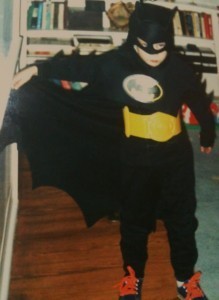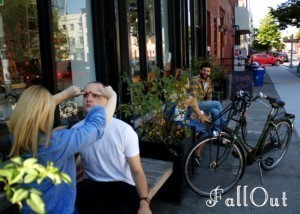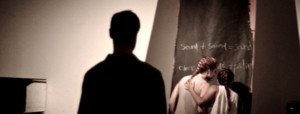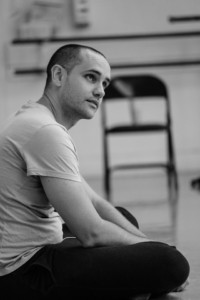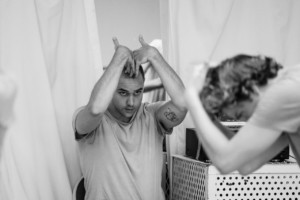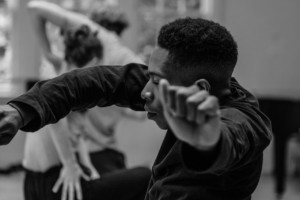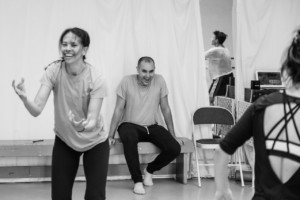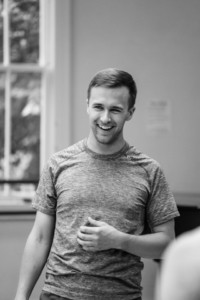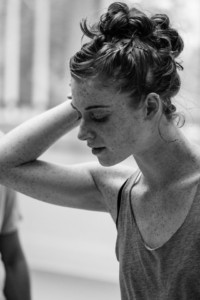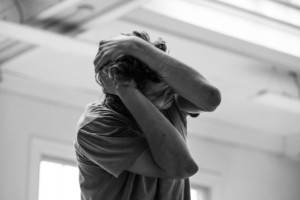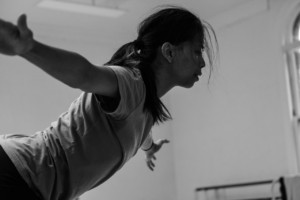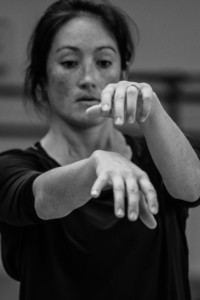Like many imaginative kids, Brendan Duggan, who grew up in Amherst, New Hampshire, loved dressing up in costumes. But he only came to dance relatively late, in high school at 16. Before that he did sports, “But to get really good at them, you had to be really competitive, and that just wasn’t me,” he says. When a friend needed a buddy to try out a ballet class, Brendan obliged and hasn’t stopped dancing since. “I loved the study and how hard it was and the self-correction.”
Brendan went on to Skidmore College. He had just started dance and he wanted to keep his options open, so he majored in dance but with a math minor, graduating magna cum laude. In Brendan’s mind, math is “a natural complement to dance: the hard work, the slow progress, smoothing transitions, solving problems.”
After graduation Brendan went to New York “to learn, and to turn what I learned into dance.” His original idea at that point was to dance first, while he could, then choreograph. But quickly, “I found dancing for other choreographers to be only partially satisfying and I was looking for more. I still enjoyed dancing for many of the choreographers I worked with, but that inner choreographic voice started speaking louder and louder.” He finally decided he needed to become a choreographer himself. Soon after, as a way of accomplishing this, he got together with a couple of others of similar views about supporting and including dancers and the need for “collaboration with artists in a range of mediums including dance, theater, multimedia, set design, and costume design.” LoudHoundMovement (LHM), “a New York City-based contemporary dance collective” was born of those impulses to create and perform. As one of his collaborators told Dance Enthusiast, “Making work [in New York City] is so economically unstable if you want to do it yourself…that’s why we wanted to work together: so we could help each other out with all of that…. What we need are people who are good administrators and can be proactive on their own, but, also, be artistically driven, which is really hard to find in one person.”
The modus operandi of LHM is captured nicely in this description (from BroadwayWorld.com/DanceWorld.com) of an evening-length work put on in New York at the inaugural Excognito Dance Festival in 2016: “The Plague of Dreams is inspired by Lindsay Stern‘s novella Town of Shadows. Like Stern’s book, the piece is a series of abstracted vignettes peeking into the lives of a town’s artistically oppressed citizens, who seek alternative and often fantastical methods of self-expression. LoudHoundMovement choreographers Duggan and Lynn interpret the text’s themes of loss and identity by following the experience of a main character on his journey through his metaphor-drenched memories. Originally conceived and performed as an immersive installation, it will be re-imagined for {the current] space with creative input from the current cast.”
LoudHound Movement “continued on quite successfully for 6 years,” says Brendan. Dance Enthusiast also numbered them among “New York City’s most promising movers and shakers.” But at the end of this time, the co-directors realized that “we were going to have to decide if our common enterprise was going to become a full-time company with tax exempt status, tours, etc. or if we were going to start fresh and go in our different directions.” The latter choice was made a year ago, and since then Brendan has been experimenting, “working with different dancers and finding what’s working for me on my own. Which brings us to now.”
And now brings Brendan to Whim W’Him and Choreographic Shindig IV. At this stage in his career, Brendan is “ambitious to do commissions, looking beyond New York City. I think NY is getting a little tired for me.” He says he wants to use the information that he gets from this stage in his life and career, working to eventually create a company again. “I’m trying to be considerate and patient” to develop something long-lasting, a new model for a future company, and to assemble a fund of repertory.
“I’ve been thinking about this for a long time,” he notes. He is attracted to immersive theater, where a performance may occur on a crowded street or in a park without the passers-by necessarily even realizing it, or in a theater but by engaging the audience as part of the show, or at least emotionally. “There are too many performances where everyone loves it, but they aren’t involved and don’t know what to say about it after it’s over.” Somehow, “It needs to stick.”
He is trying to evolve a style of creativity involving: “Reactions. Honesty. Form and process rather than shape.” And to this end, “We need to use storytelling in an open way, not like chapters in a book but access to points that connect, maybe moments of connection,” with music and costumes as a part of the evocation. “Contemporary dance is so abstract,” says Brendan. In a way, that’s just what is compelling about it, but it also needs to reach people in a way that is sometimes easier for the more verbal arts. He is, not surprisingly, very interested in “words and the parallels between art forms and how people react and take art in.”
In film or plays, “You can tell if it’s good or bad: ‘I didn’t believe it, they were terrible actors…” And that is true with movement too. “You can tell if dramatic,” or melodramatic or simply unclear. “When people feel they need the message, it needs to be very clear. I think what I’m looking at is habits of story-telling.” Brendan is much taken with the stories of Raymond Carver, which are usually slow and quiet and aren’t big on plot, but they ask questions. The people in the stories try to answer them and come to some sort of conclusion—or don’t. The piece Brendan has created with the Whim dancers, although very different in atmosphere and pace, has some of that same sense of its point being to pose not to answer questions for the people inside it.
The first time I spoke with Brendan, I asked what was he was wanting to explore on coming into the studio with the Whim W’Him dancers. “Skin,” he said promptly and wanting to be in someone else’s skin” or not. “A lot is about movement development. I really want to focus on people reacting to things. If there is no cause for something to happen, nothing may happen.” There was a long stage of development, a lot of open improv, with the dancers concentrating more on exploring their characters than explicitly on generating movement. There was no particular shape to the exercises at first, says Brendan. Out of the material that emerged, his job was choose and shape, balancing the theatrical and the choreographic. But most important was for the dancers themselves “to own it.” They were working out “who each person will be in the piece, so that they feel comfortable in it,” in that skin. In the studio, he says, “I’ve done a lot of watching, while the dancers solved problems.” It’s a question of establishing trust, he avers. “It’s an awkward, hands off experiment, that won’t work if they don’t believe or it feels forced.”
One of the situations explored was a superficial gathering, “like a cocktail party. Host, guests. What do you want? Attention—or a way out?” They probed, say Brendan, “Questions. Insecurities. The voids you ignore.” They delved into the idea of “aloneness vs loneliness” and how people put on faces and ways of acting and of relating to each other that may have very little to do with who they are underneath.
And by now, by showtime, it’s become a full-fledged party, complete with program notes in the form of an invitation:
And the whole group of other characters, some recognizable from the dancers’ own overt personalities, some just the opposite of what you’d expect—a drunkard, a self-obsessed flirt, an earnest nerd, an anxious boyfriend. Words are a big part of it, but they don’t actually say very much, or rather there are so many that they convey little in themselves. The idea of chatter is a central part of the scene, huge numbers of words cascading out—much of it generated on the spot by the dancers in the characters they inhabit here—yet almost devoid of meaning.
In the midst of all the verbal cacophony one of the party-goers gets more and more out of sync with the others.
All of a sudden, the bottom falls out of the flimsy social world of the seven characters, as if we’re dropped into a subterranean cavern. The jabbering and gesticulating, the posing and preening fade away into… what? Deep feelings? Hidden passions? Secret fears and desires that will never meet the light of day? Dreams or flights of imagination?
In this piece, Brendan has made the interesting choice not to focus on just one or two protagonists, but to tackle the tales of 7. As he said to me yesterday, “In a way I’d like to be able to add on about 30 minutes” and explore more fully all their different stories. But there is a way in which a lack of tidy conclusions about all the characters’ issues gives, to my mind, far more of a feel of real life, where for any cross-section of people, even at a some highly significant moment, some of their problems will be being solved, some will still be in the process of figuring things out and still others will not even recognize they have any problems, while some might just being reaching real insight.
Photo credit: The 3rd image and the last 8 are by Stefano Altamura @salt.photo
